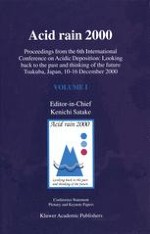2001 | OriginalPaper | Chapter
Effects of Site Selection Strategy on Freshwater Critical Load Exceedances in Wales
Authors : C. J. Curtis, R. Harriman, M. Hughes, M. Kernan
Published in: Acid rain 2000
Publisher: Springer Netherlands
Included in: Professional Book Archive
Activate our intelligent search to find suitable subject content or patents.
Select sections of text to find matching patents with Artificial Intelligence. powered by
Select sections of text to find additional relevant content using AI-assisted search. powered by
Critical loads are used in international negotiations to reduce acid deposition resulting from emissions of sulphur and nitrogen compounds within Europe. For freshwater ecosystems, the First-order Acidity Balance (FAB) model is used to generate national maps of critical loads and exceedances for both sulphur (S) and nitrogen (N). In Wales, two survey datasets have been used to calculate critical loads and exceedances; one based on water bodies selected to be “mostsensitive” to acidification within a 10 km grid and the other based on a random selection of standing waters. Both datasets indicate that critical loads were exceeded in 1990 in a significant proportion of Welsh lakes and streams; 36% of sites in the grid-basea survey and 31% of sites in the random survey. However, implementation of the Gothenburg Protocol would protect all but 6% of sites in the grid-based survey and all sites in the random survey. Assessment of the relative success of the Gothenburg Protocol in protecting Welsh freshwater ecosystems therefore depends on the site selection strategy employed.
